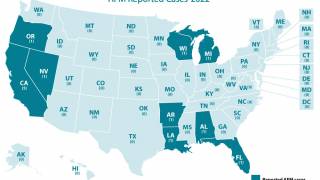CDC Seeks Help Finding AFM Cases in 2019

As the 2019 Fall “season” approaches, so do cases of the Acute Flaccid Myelitis (AFM) accelerate.
So far in 2019, there have been 11 confirmed AFM cases in the states of California, Maryland, Nebraska, North Carolina, Texas, Utah, and West Virginia.
During 2018, 233 AFM cases occurred in 41 states, spiking between August and October every other year. The state of Texas reported 29 AFM cases in 2018.
That is why the Centers for Disease Control and Prevention (CDC) is calling on medical professionals to quickly recognize AFM symptoms and report all suspected cases to their local health department.
The CDC said in a press release on July 10, 2019, that early recognition and reporting are critical for providing patients with appropriate care, rehabilitation, and better understanding AFM, according to a new Vital Signs report.
The CDC says it generally received reports of suspected AFM cases 18 days after the patient’s limb weakness began.
“CDC continues to pursue the definitive cause and mechanisms that define this disease and we sincerely appreciate the important contributions of the AFM Task Force in helping us get closer to critical answers,” said CDC Director Robert Redfield, M.D.
“I urge physicians (pharmacists and nurses) to look for symptoms and report suspected cases so that we can accelerate efforts to address this serious illness.”
Symptoms
AFM is believed to be caused by certain infections—most of them viral—that attack the spinal cord and damage it. Most of these viruses—known as enteroviruses—are common infections that everyone eventually acquires.
No one knows why these viruses affect the spinal cord in only a tiny fraction of the population.
Since AFM can progress quickly from limb weakness to respiratory failure requiring urgent medical intervention, rapidly identifying symptoms and hospitalizing patients are important.
The majority of AFM patients are previously healthy children who had respiratory symptoms or fever consistent with a viral infection less than a week before they experienced limb weakness.
CDC began tracking AFM in 2014 when the first outbreak of 120 cases occurred. Another outbreak occurred in 2016 with 149 cases.
AFM news
- 7 AMF Cases Reported in 2019
- EV-D68 Virus Identified as a Cause of Acute Flaccid Myelitis
- Public Health England Issues Initial AFP/AFM Report
In an analysis of cases confirmed in 2018, CDC detected enteroviruses and rhinoviruses in nearly half of respiratory and stool specimens. Of the 74 cases with a cerebral spinal fluid specimen, only two were positive for enteroviruses (EV-A71 and EV-D68).
The CDC and other scientists continue to investigate how enteroviruses, including EV-D68, might initiate AFM. All specimens tested negative for poliovirus, a related enterovirus that can cause AFM.
Vital Sign publishes the latest data and information on key health indicators as part of the CDC’s Morbidity and Mortality Weekly Report.
Our Trust Standards: Medical Advisory Committee
























